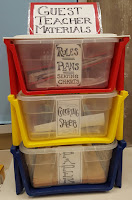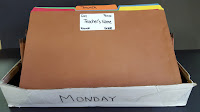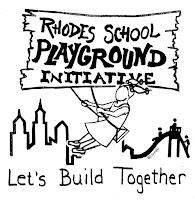Being a good teacher is hard work, but being a successful teacher takes some serious trial-and-error. As a gift to other art teachers out there, I'd like to share ten tips and hard-learned lessons I've learned that make my everyday teacherin' life a little bit easier. Everyone makes mistakes (see #10), but in sharing my experiences I hope to help other teachers enjoy more moments of success and better preservation of their sanity.
Preparing to Succeed:
An Art Teacher's Guide
 |
| My grab-and-go kit: Rory's Story Cubes, color & shape bingo, Beautiful Oops, paper, instructions for simple book making projects, crayons, colored pencils, and coloring pages. |
When another teacher's parent conference or last-minute absence happens during your prep period, you might get called on to cover their class. Getting advance notice of a coverage is often a luxury, so prepare yourself with activities that are suitable for a variety of ages and are easy to modify!
2. Always leave your classroom sub-ready
 You never know what is going to happen after you exit school for the day, so make sure that nothing is left to chance. Lock up things that are not for students, have sub plans easily accessible, and make sure the room is tidy.
You never know what is going to happen after you exit school for the day, so make sure that nothing is left to chance. Lock up things that are not for students, have sub plans easily accessible, and make sure the room is tidy.3. Streamline your paperwork
I like to have frequently used data at my fingertips. Behavioral notes & attendance are on my seating chart, and contact info & grades are on a roster sheet. The pages face each other in my binder for easy access.
4. Find an organizational system that is easy to maintain, then stick with it
 Have easy-to-understand systems for organizing student work, paperwork, and student procedures. Being disorganized in an art room is like trying to clean up a gallon of paint with one paper towel. It might work eventually, but you'll have a heck of a mess on your hands!
Have easy-to-understand systems for organizing student work, paperwork, and student procedures. Being disorganized in an art room is like trying to clean up a gallon of paint with one paper towel. It might work eventually, but you'll have a heck of a mess on your hands!
5. Keep guidelines clear and simple
When you clearly post simple rules and procedures, you eliminate confusion and frustration for you and your students!
When you clearly post simple rules and procedures, you eliminate confusion and frustration for you and your students!
6. If a student can do something, let them
There is no reason to clutter your mind with project distribution when you are tasked with facilitating the education of 30+ students while also keeping them safe. Use your first few classes to teach and reinforce classroom rules adn procedures, then hold them accountable. Make your classroom a more student-driven educational environment while keeping your eyes and ears open for teachable moments and potential issues!
7. Common sense is not the same for everyone
Dictionary.com defines common sense as sound practical judgment that is independent of specialized knowledge, training, or the like; normal native intelligence. Remember: sound and practical looks very different to an adult from the suburbs than it does to child from the inner city.
8. Become indispensable
 When school and district budgets get tight, art education is one of the first areas to get cut. This is often due to the perceived expense of running a quality program. Make yourself an important part of your school's culture and a valued member of the school community by volunteering for initiatives and building committees. Being an intrenched, highly visible, and POSITIVE influence makes keeping you in your position a higher priority.
When school and district budgets get tight, art education is one of the first areas to get cut. This is often due to the perceived expense of running a quality program. Make yourself an important part of your school's culture and a valued member of the school community by volunteering for initiatives and building committees. Being an intrenched, highly visible, and POSITIVE influence makes keeping you in your position a higher priority.
9. Be an informed advocate
Advocating for your subject, program, and students makes you a force for positive change. Gandhi is often quoted as having said "Be the change you wish to see in world." Show, tell, and demonstrate why and how art is important, but check your facts first. If you're not sure where to start, try looking up the philosophy research of Elliot Eisner through reading his work or hearing him speak. You can also print a copy of his 10 lessons the arts teach to post in your classroom!
10. Learn from your mistakes
We all make mistakes, it's part of life. The biggest mistake that I made during my first few years as an art teacher was taking myself too seriously. It stunted the development of my relationships with both my students and other adults. The first few years of teaching is hard enough as it is, I made my own life far more difficult than it should have been by leaving my sense of humor at home. Recognize when you've made a mistake and take the time you need to reflect. What went wrong? How it could be fixed or done better in the future? Ask for help when you need it and don't forget to celebrate your victories... you earned them!
Bonus tip: Test run every project with the exact same supplies that your students will be using. It may be a pain in the neck, but troubleshooting your lessons in advance makes for a much smoother and enjoyable classroom experience for everyone!
7. Common sense is not the same for everyone
 |
| Positively worded rules get better results! |
 When school and district budgets get tight, art education is one of the first areas to get cut. This is often due to the perceived expense of running a quality program. Make yourself an important part of your school's culture and a valued member of the school community by volunteering for initiatives and building committees. Being an intrenched, highly visible, and POSITIVE influence makes keeping you in your position a higher priority.
When school and district budgets get tight, art education is one of the first areas to get cut. This is often due to the perceived expense of running a quality program. Make yourself an important part of your school's culture and a valued member of the school community by volunteering for initiatives and building committees. Being an intrenched, highly visible, and POSITIVE influence makes keeping you in your position a higher priority. |
| My art advocacy bulletin board features Eisner, Gardner, and tons of art-based career choices! |
Advocating for your subject, program, and students makes you a force for positive change. Gandhi is often quoted as having said "Be the change you wish to see in world." Show, tell, and demonstrate why and how art is important, but check your facts first. If you're not sure where to start, try looking up the philosophy research of Elliot Eisner through reading his work or hearing him speak. You can also print a copy of his 10 lessons the arts teach to post in your classroom!
10. Learn from your mistakes
We all make mistakes, it's part of life. The biggest mistake that I made during my first few years as an art teacher was taking myself too seriously. It stunted the development of my relationships with both my students and other adults. The first few years of teaching is hard enough as it is, I made my own life far more difficult than it should have been by leaving my sense of humor at home. Recognize when you've made a mistake and take the time you need to reflect. What went wrong? How it could be fixed or done better in the future? Ask for help when you need it and don't forget to celebrate your victories... you earned them!
Bonus tip: Test run every project with the exact same supplies that your students will be using. It may be a pain in the neck, but troubleshooting your lessons in advance makes for a much smoother and enjoyable classroom experience for everyone!
What would you add to the list?
Share with us by commenting below!



No comments:
Post a Comment